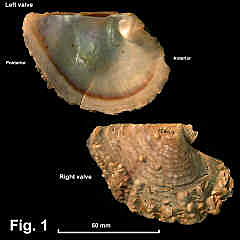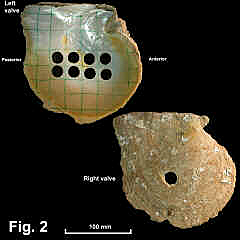|
|
MARGARITIDAE |
|
|
|
Pinctada maxima (Jameson, 1901) Description: Shape Shell very oblique when juvenile (Fig. 1), less oblique when adult (Fig. 2), with left valve more inflated than right; umbo near anterior end of dorsal margin; dorsal margin straight, anterior margin with deep byssal notch in right valve, posterior margin straight or concave, ventral margin rounded. Hinge line straight, ligament in a broad triangular pit behind umbo. Interior nacreous silver-grey, sometimes with a golden band on the edge, and a wide uniformly coloured non-nacreous margin; muscle scar large and wide. Exterior with concentric foliaceous laminae with foliaceous processes in radial rows, eroded away in mature shells. Shell colour variable; usually pale yellow-grey, sometimes with dark green or purple-brown rays. Size: Up to 282 mm in length, but usually much smaller. Distribution: Central Indo-West Pacific; Myanmar eastwards to Polynesia and southwards to northern Australia. In Australia from Shark Bay, WA, around northern Australia, to Solitary Island (near Coffs Harbour) NSW, and rarely as far south as Sydney. Habitat: When young, lives attached to a hard substrate by a byssus, but becomes unattached with growth and lives freely on sand, gravel or coral rubble down to 80 metres, most commonly in 30-40 metres (Allan, 1950). Comparison: See Pinctada fucata. Remarks: This is the Golden-lip or Silver-lip Pearl Shell, harvested for mother-of-pearl shell and farmed for pearl production. Fig. 1: Sydney Harbour, pre-1977 (C.011837) Fig. 2: Darnley Reef, Torres Strait, Qld (C.98286) |
|

